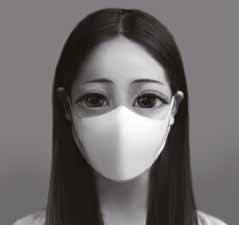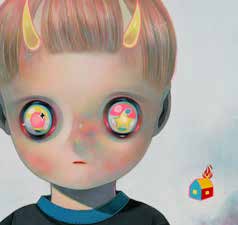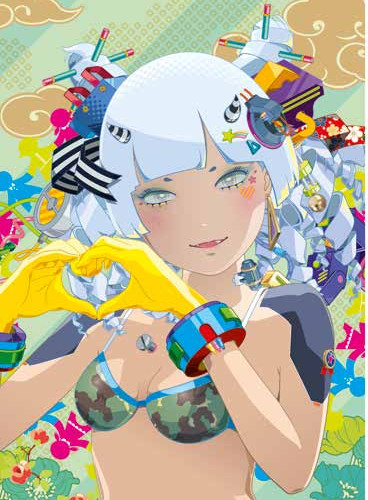Japan Pop
- noname
- 25 apr 2020
- Tempo di lettura: 3 min
The new post-Murakami creative generation on stage with the exhibition Japan Pop and Nipposuggestioni: Tomoko Nagao, Hiroyuki Takahashi, Hikari Shimoda and Hitomi Maehashi. After the Milanese success of Japan Pop Art Preview in February 2016, the four artists Tomoko Nagao, Hiroyuki Takahashi, Hikari Shimoda and Hitomi Maehashi are back in the spotlight with the exhibition "Japan Pop and Nipposuggestioni", scheduled in Bologna, first at La Ferramenta in via delle Moline 16/A, from 27 to 31 January, and then at Galleria Cavour 1/L, from 1 to 25 February. Four artists, four different styles and aesthetic languages for a single common denominator: Japanese culture. The world of anime and manga lives in the works of Tomoko Nagao, Hiroyuki Takahashi, Hikari Shimoda and Hitomi Maehashi. These four diamond points embody the manifesto of the latest artistic trends of the Rising Sun and the following generation to the great masters of Superflat style Takashi Murakami and Nara Yoshitomo. Today Japan is a world trendsetter, an artistic power comparable to the United States of the last century: a hotbed of talent and an unstoppable laboratory of ideas, to which it is impossible not to turn your interest.
The curatorial project for Deodato Arte, created by Christian Gangitano, one of the leading experts on Japanese pop culture and art in Italy, is itinerant, a successful format that has attracted many young people: a sign of the liveliness of the market and the awakening of a new generation of collectors, attentive to the latest trends. The exhibition moves the steps from the most iconic work of Japanese art. The great wave of Hokusai's Kanagawa, also reinterpreted by artist Tomoko Nagao. His contemporary version, entitled The Great Wave of Kanagawa with mc, cupnoodle, kewpie, kikkoman and kitty, is a subtle and ironic critique of society, softened by the Japanese kawaii aesthetic, which makes every element cute and loving, even a tsunami, not sparing no subtle criticism of environmental consumption society and the causes of ecological disasters. Tomoko Nagao was born in 1976 in Nagoya, Japan, but currently lives and works in Milan, and is recognized as the most important exponent of MicroPop Art and SuperFlat in Italy. Her works relive masterpieces of classical art: iconic works by Caravaggio, Botticelli, Velazquez, Titian revisited in a pop key and reinterpreted according to the kawaii aesthetic. They are divided into oil paintings, vectorial art and stencils. Among his vectorial works stands out The Birth of Venus with kisses, recently exhibited at the Gemalde Galerie in Berlin in the exhibition The Botticelli Renaissance and at the Victoria & Albert Museum in London. From Tomoko Nagao's kawaii aesthetic to the mood shōjo language of Hiroyuki Takahashi's works. Particularly well-established in Tokyo, where she is considered a true star, Takahashi creates digital works that embody the principles of the Shōjo tradition, a neo-feminist culture with transgressive traits. Launching strong messages of emancipation, the artist portrays girls inspired by manga and often suffering from deep identity crises, inserting them in urban contexts. Takahashi is also very popular in the world of fashion and design; with his graphics, in fact, are made clothing and gender gap gadgets, much appreciated in Japan.
Hikari Shimoda is the third highlight of the exhibition. Shimoda is also inspired by the world of Manga and Souls, reconnecting to the style called irasuto, a term used in Japan for illustration. In his works already exhibited in Japan, Canada, the United States and Italy, created with extraordinary technical skill, reality meets the fantastic world and elements of tenderness and horror coexist, creating an innovative and contemporary artistic language, full of symbolic meanings.
The protagonists of Shimoda's paintings are often children as superheroes or magical girls, whose eyes become a mirror of contemporary social issues. Their innocence and simplicity is an opportunity for Shimoda to underline the importance of the growth and formation of the new generations. With the help of adults, children should learn to look at this chaotic world, know its history and hope for a better future. Children of this planet 24 and Children of this planet 30 will be among the works of Shimoda in the exhibition. Hitomi Maehashi, born in 1989 in Aichi, Japan, attended the same art school as master Nara Yoshitomo and pop artist Tomoko Nagao; today she is recognized as an exponent of digital painting on photography: an innovative artistic technique that goes beyond the use of Photoshop, photo-retouching and digital graphic painting: a meticulous and avant-garde style, particularly representative of new Japanese artistic trends. After taking photographs of ordinary people or herself, Hitomi Maehashi modifies the images on the computer, combining reality at times characteristic of Manga and Anime culture, drawing inspiration from the practice of cosplay and Japanese masks called Kigurumi.


























































Commenti